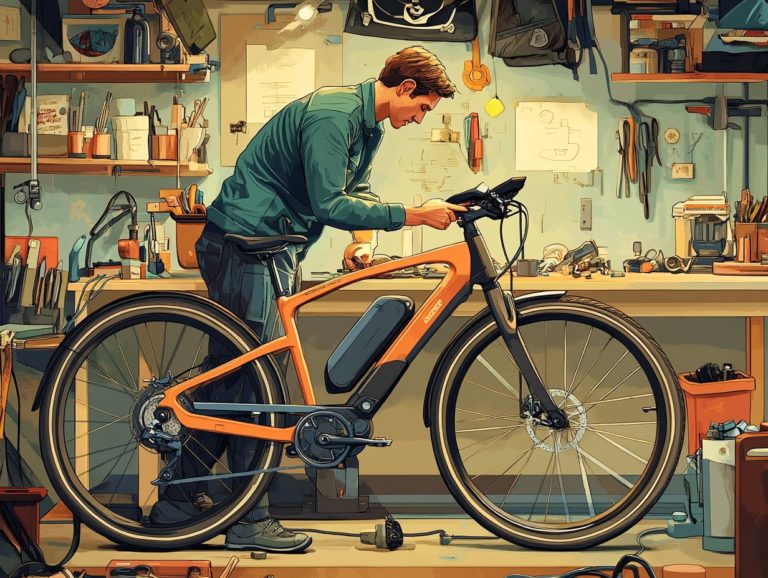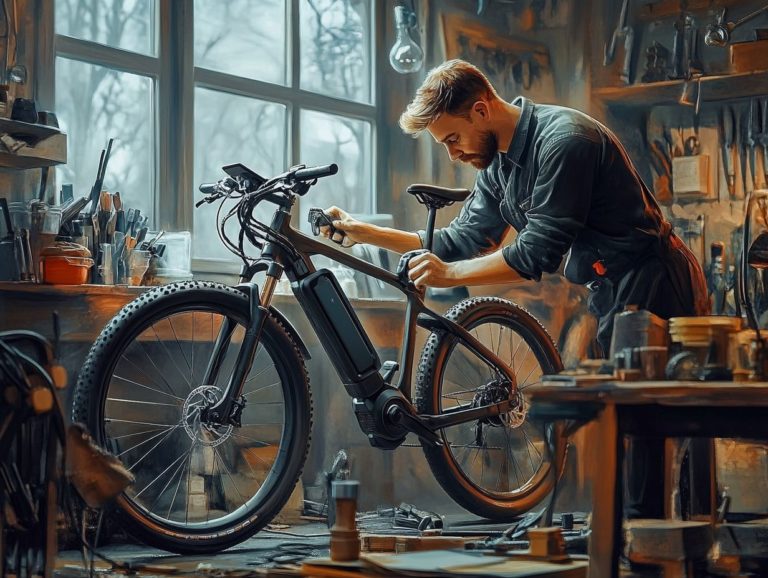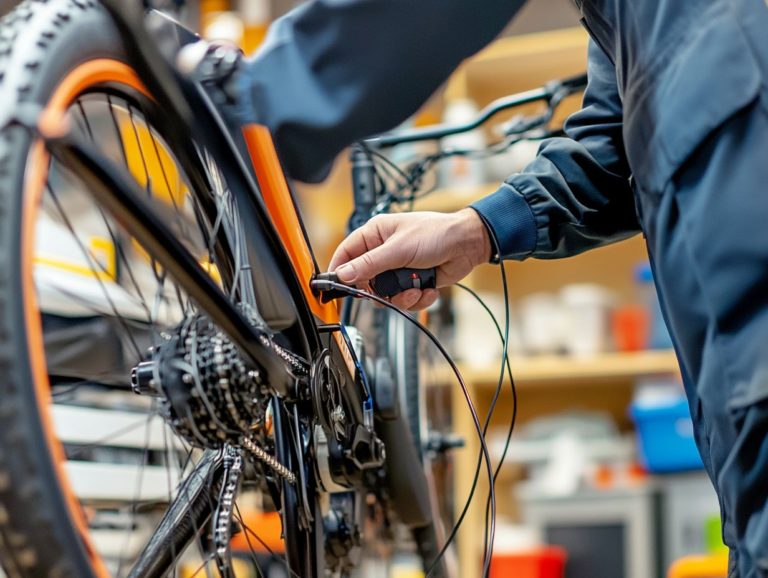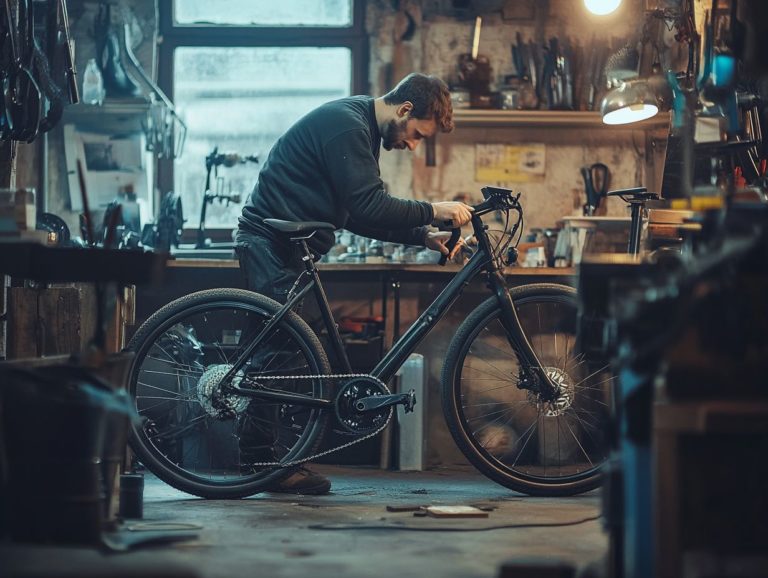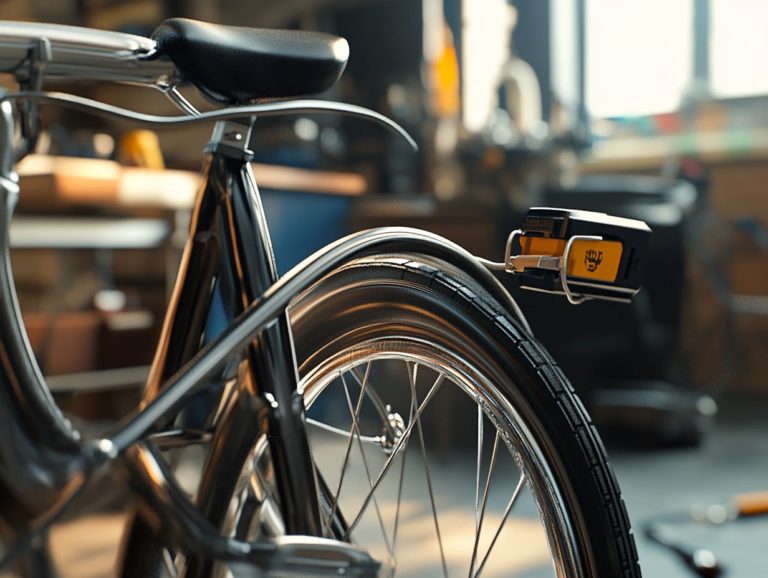How to Care for Your Electric Bicycle’s Brakes
When it comes to riding electric bicycles, or e-bikes, one of the most critical components for your safety and how well your bike rides is the braking system. Just like any other part of your e-bike, your brakes need regular brake maintenance and attention to ensure they operate effectively.
This article delves into the various types of brakes used in electric bicycles, including hydraulic brakes and mechanical brakes. It emphasizes the importance of maintaining them, with practical maintenance tips for brake inspection, cleaning, and troubleshooting issues that may arise.
You ll also discover when to replace worn brakes and best practices to extend their lifespan, especially regarding brake pads and brake calipers, which help the brakes clamp down on the wheel.
Mastering brake cleaning and care will keep your ride safe and enjoyable!
Contents
- Key Takeaways:
- Types of Brakes Used in Electric Bicycles
- Importance of Maintaining Electric Bicycle Brakes
- Basic Maintenance for Electric Bicycle Brakes
- Replacing Worn Brakes
- Troubleshooting Common Brake Issues
- Tips for Extending the Lifespan of Electric Bicycle Brakes
- Frequently Asked Questions
- 1. How do I maintain my brakes?
- 2. How often should I replace my brake pads?
- 3. How can I tell if my brakes need adjustment?
- 4. Is it necessary to bleed the brake technology and design on my electric bicycle?
- 5. How can I prevent my electric bicycle’s brakes from overheating?
- 6. Can I use the same brake maintenance techniques for both electric and traditional bicycles?
Key Takeaways:
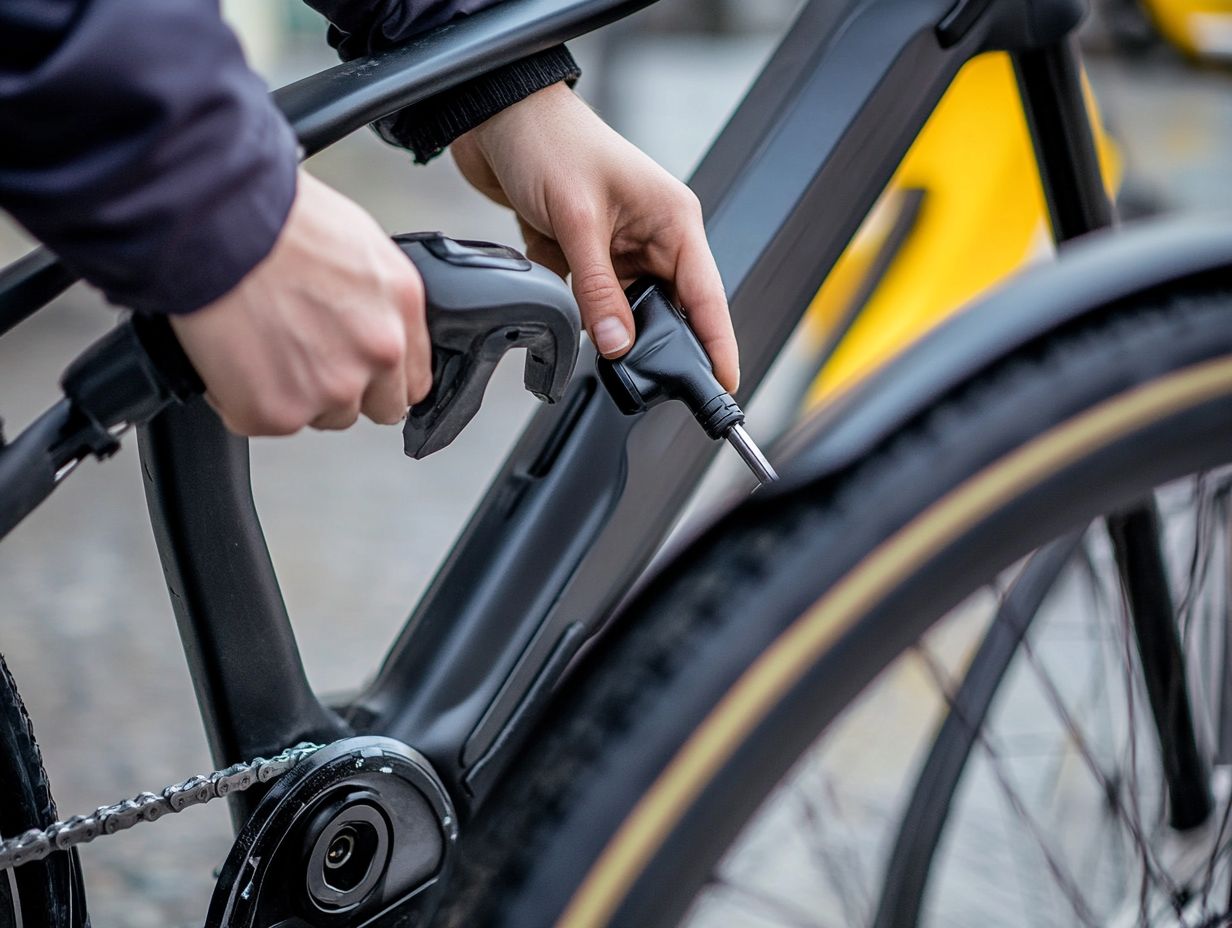
- Regular maintenance and inspection of electric bike brakes is crucial for safety and optimal performance.
- Knowing when to replace worn brakes and how to do it properly can save you time and money, ensuring your brake performance is effective.
- Follow best practices for brake care, such as brake cleaning and troubleshooting common issues, to extend the lifespan of your electric bicycle’s brake systems.
Types of Brakes Used in Electric Bicycles
Electric bicycles, or e-bikes, feature a variety of braking systems that play a crucial role in their performance and overall riding experience. The two main types of brakes you ll encounter are hydraulic brakes and mechanical brakes. Each provides distinct advantages that can enhance your braking performance and boost your confidence on the road.
Notable brands like Magnum and Shengmilo have incorporated advanced brake systems to elevate safety features. It’s essential for you to grasp the differences between these brake technologies to make informed choices.
Importance of Maintaining Electric Bicycle Brakes
Maintaining the brakes on your electric bicycle is vital for ensuring both safety and optimal performance. Regular inspections are essential to spot any wear or degradation that could compromise your stopping power, especially in urban environments where riding behaviors can differ dramatically.
By adhering to brake safety standards, you boost your confidence on the road and extend the lifespan of your brake systems.
Ensuring Safety and Optimal Performance
Ensuring your safety and how well your bike rides requires a keen understanding of the vital role that brake components and systems play in delivering effective stopping power. The decision between hydraulic and mechanical brakes can dramatically impact your braking distance and the overall safety features of your e-bike, ultimately influencing your confidence in various riding conditions.
Braking technologies, such as disc brakes, enable e-bikes to seamlessly transition between urban landscapes where sudden stops may be necessary and rural trails that demand reliability over longer distances.
In the hustle and bustle of city streets, strong brake efficiency is crucial as you navigate unpredictable traffic and pedestrians. Conversely, robust brake systems in rural settings help you manage descents and tackle uneven terrain, instilling a sense of assurance as you ride.
A reliable braking system not only shortens your stopping distances but also enhances your entire riding experience, enabling smooth transitions and greater control. This ultimately fosters a deeper trust in the performance of your e-bike, allowing you to ride with confidence.
Basic Maintenance for Electric Bicycle Brakes
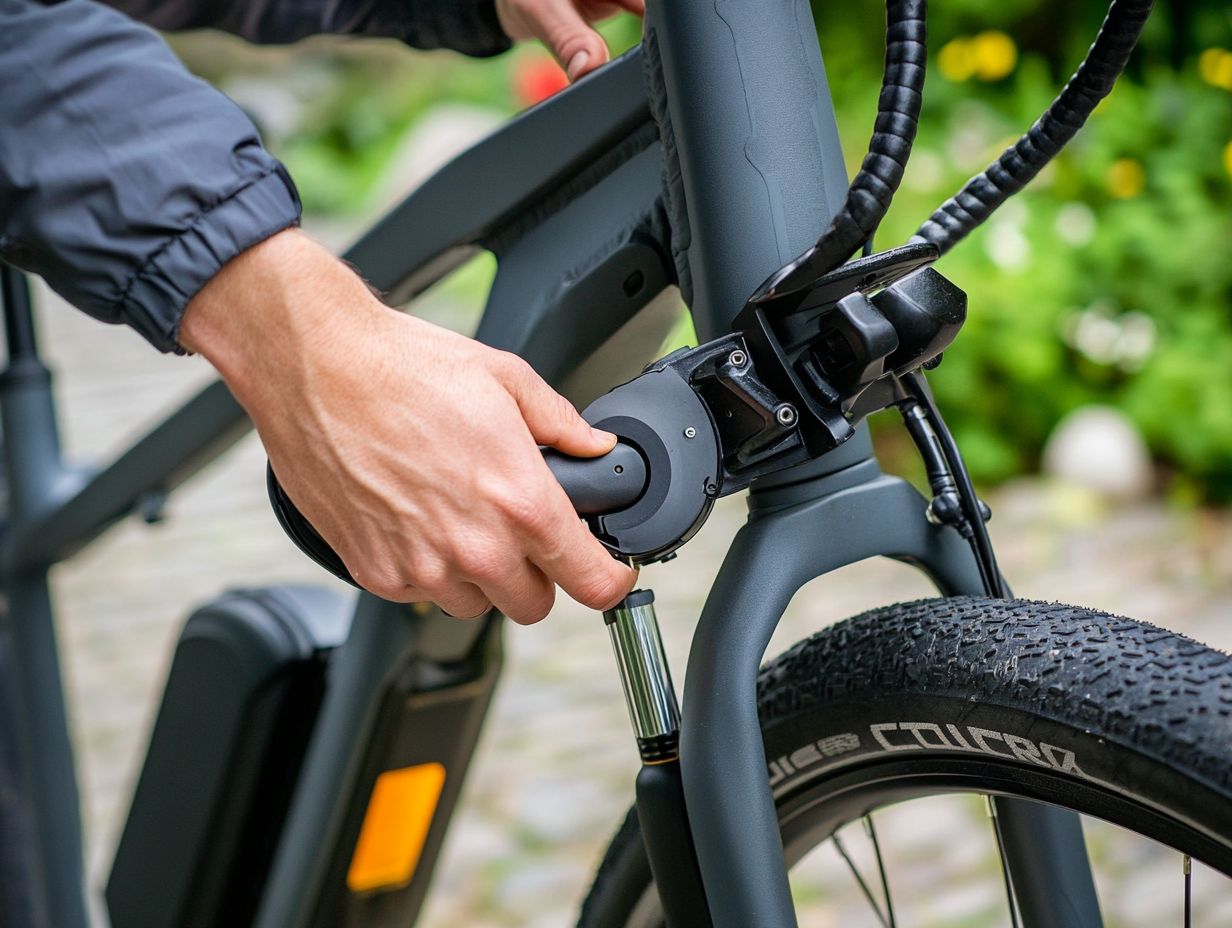
Basic maintenance for your electric bicycle brakes requires regular cleaning and adjustments to ensure they function optimally and last longer. Paying attention to these details boosts your brakes’ reliability and enhances your ride!
By committing to routine bike care, you enhance the performance of both hydraulic and mechanical brakes while extending the lifespan of crucial components, such as brake pads and calipers.
Cleaning and Inspecting Brakes
Cleaning and inspecting brakes is an important step in maintaining your electric bicycle, ensuring that every component, from brake pads to brake fluid and rotors, is in peak condition. Regularly checking your brakes allows you to spot issues like wear and contamination early, leading to timely maintenance that enhances braking performance and keeps you safe on the road.
To get started, begin with a thorough cleaning of your brake pads and rotors. A dedicated brake cleaner will effectively eliminate dust and grime, while also giving you the chance to check for uneven wear or cracks in the pads.
Don t underestimate the importance of checking your brake fluid levels; topping them up with the correct type can be the difference between a smooth ride and a braking failure. Check rotor alignment. Any misalignment can reduce efficiency and cause unwanted noise.
By diligently following these best practices, you ll ensure that your braking system operates at its finest, giving you peace of mind as you ride.
Replacing Worn Brakes
Replacing worn brakes is vital for maintaining both the performance and safety of your electric bicycle, particularly regarding crucial components such as brake pads and calipers. By recognizing the signs of brake wear and knowing the right time to replace these parts, you not only ensure optimal braking performance but also extend the lifespan of your bicycle’s braking system.
When to Replace Brakes and How to Do It
Knowing when to replace your brakes is essential for maintaining the safety and performance of your e-bike, as well as complying with the laws surrounding maintenance and safety standards. If you notice a gradual decline in stopping power or hear a grinding noise when engaging the brakes, it s time to pay attention these are clear signs that your brakes need some tender loving care. Don’t wait too long! Safety on the road is your priority.
It s crucial to familiarize yourself with common symptoms of brake issues, like vibrations or a spongy feeling when you pull the lever. These could indicate air bubbles in the brake lines or worn pads.
Once you ve identified the problem, replacing the brake components is straightforward:
- Gather the necessary tools, like a wrench and replacement pads.
- Follow a step-by-step guide to ensure a secure installation and optimal performance.
Your e-bike deserves it, and so do you.
Troubleshooting Common Brake Issues

Troubleshooting common brake issues is crucial for preserving the reliability and safety of electric bicycles. After all, the performance of brakes can significantly influence your confidence as a rider and your overall enjoyment of the ride.
By identifying problems during brake inspections such as diminished braking efficiency or unusual sounds you enable yourself to make timely repairs and adjustments, ensuring that your bike operates at its best.
Identifying and Fixing Problems
Identifying and resolving issues with electric bike brakes requires a careful assessment of how well your brakes work and a thorough inspection of critical components such as brake pads, fluid levels, and calipers. By understanding the mechanics and design of the braking system, you can proactively address potential problems to ensure that your brakes function effectively and safely.
- Pay close attention to your bike s responsiveness while riding. Notice any delays in braking or unusual sounds as early warning signs of trouble.
- Inspect the brake pads for wear worn pads drastically reduce your braking efficiency.
- Check the brake fluid levels regularly. You may need to top them off or flush the system if the fluid looks dirty.
- Examine the brake calipers for signs of damage or misalignment to identify further issues.
By systematically evaluating these components, you can enhance your riding experience and extend the lifespan of your brakes.
Tips for Extending the Lifespan of Electric Bicycle Brakes
Want your brakes to last longer? Here s how! You can extend the lifespan of your electric bicycle brakes through proper maintenance practices that enhance both longevity and performance:
- Routine brake cleaning
- Regular inspections
- Utilizing advanced brake technology
Implementing these strategies will significantly boost the durability and reliability of your braking systems.
Best Practices for Brake Care and Maintenance
Best practices for brake care and maintenance are crucial for ensuring the safety and effectiveness of your electric bicycle s braking system. Regularly clean your brakes, make timely adjustments, and monitor all brake components. Each contributes to optimal performance and your safety while riding.
Prioritize routine inspections of the brake pads to ensure rider behavior meets safety regulations. This helps maintain braking performance and durability for both urban and rural riding.
Spotting signs of brake wear early can help you avoid significant issues and ensure a smooth ride. Don t forget to clean and lubricate moving parts, like cables and levers, as this simple act can enhance responsiveness and prolong the lifespan of your braking system.
Investing time in these practices not only maximizes brake efficiency but also boosts your rider confidence as you navigate various terrains. Effective brake maintenance for e-bikes is essential!
Frequently Asked Questions

1. How do I maintain my brakes?
Regularly check and clean your brake pads, rotors, and calipers to remove debris or buildup that could affect performance. Tighten any loose bolts or cables and replace worn-out brake pads.
2. How often should I replace my brake pads?
This depends on how frequently you ride and the terrain. Generally, brake pads should be replaced every 1,000-2,000 miles to ensure optimal braking performance.
3. How can I tell if my brakes need adjustment?
If your brakes feel spongy, make strange noises, or take longer to stop, they likely need adjustment. You can also visually inspect the brake pads for wear and tear.
For a professional check-up, consider visiting your local bike shop!
4. Is it necessary to bleed the brake technology and design on my electric bicycle?
Bleeding the brakes isn’t always needed. However, it can significantly enhance performance by removing air bubbles from the brake lines. Experience the difference when you bleed your brakes!
5. How can I prevent my electric bicycle’s brakes from overheating?
To prevent overheating, steer clear of long rides down steep hills. If you face a steep descent, switch between your front and rear brakes to spread out the heat. Ride smart and keep your brakes cool!
6. Can I use the same brake maintenance techniques for both electric and traditional bicycles?
Some maintenance techniques are similar, but check your electric bicycle’s manual for specific guidance. Electric bikes have unique braking systems that might need specialized care. Get the best care for your electric bike’s unique needs!


